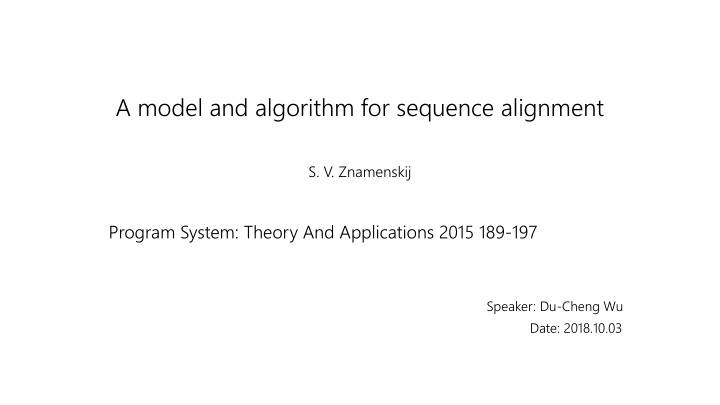
Optimizing Sequence Alignment with New Cost Function
Explore a novel cost function and algorithm for sequence alignment, addressing the limitations of traditional methods. The proposed strategy improves alignment quality and efficiency by prioritizing informative common strings and minimizing uninformative substrings. This innovative approach enhances change detection accuracy in collaborative text editing, reducing the risk of merge conflicts.
Download Presentation

Please find below an Image/Link to download the presentation.
The content on the website is provided AS IS for your information and personal use only. It may not be sold, licensed, or shared on other websites without obtaining consent from the author. If you encounter any issues during the download, it is possible that the publisher has removed the file from their server.
You are allowed to download the files provided on this website for personal or commercial use, subject to the condition that they are used lawfully. All files are the property of their respective owners.
The content on the website is provided AS IS for your information and personal use only. It may not be sold, licensed, or shared on other websites without obtaining consent from the author.
E N D
Presentation Transcript
A model and algorithm for sequence alignment S. V. Znamenskij Program System: Theory And Applications 2015 189-197 Speaker: Du-Cheng Wu Date: 2018.10.03
Abstract(1/2) The change detection problem is aimed at identifying common and different strings and usually has non-unique solutions. The identification of the best alignment is canonically based on finding a longest common subsequence (LCS) longest common subsequence (LCS) and is widely used for various purpose. However, many recent version control systems prefer alternative heuristic algorithms which not only are faster but also usually produce better alignment than finding LCS. Two basic shortcoming of known alignment algorithms are outlined in the paper: (1)even when the length of the longest common substring is close to that of the LCS LCS, the latter may consist of a great number of short uninformative substrings; LCS.
Abstract(2/2) (2)known alternative algorithms start with identifying the most informative common string, which sometimes omits from consideration common subsequence containing arbitrarily many aligned substrings of similar quality. The sequence alignment problem is considered to be an abstract model for change detection in collaborative text editing designed to minimize the probability of merge conflict. A new cost function is defined as the probability of overlap between detected changes and a random string. This optimization avoids both shortcoming mentioned above. The simple cubic algorithm is proposed.
Non-conflicting substring(NCS) A: EXTRA TETRAHEDRA B: TETRAHEDRAL HEADER LCS:ETRAERAHEDR NCS:TETRAHEDRA
Non-conflicting substring(NCS) ? = ?(? + 1) The cost function of NCS 2 String of length ? contains exactly ?(?+1) different substrings 2
Non-conflicting substring(NCS) 0 T E T R A H 0 0 T 0 R 0 A 0 T 0 E 0 T 0 R 0
Non-conflicting substring(NCS) 0 T E T R A H 0 0 0 T 0 1 R 0 1 A 0 1 T 0 1 E 0 1 T 0 1 R 0 1
Non-conflicting substring(NCS) 0 T E T R A H 0 0 0 0 T 0 1 1 R 0 1 1 A 0 1 1 T 0 1 1 E 0 1 1 0 +2 3 > 1 2 T 0 1 R 0 1
Non-conflicting substring(NCS) 0 T E T R A H 0 0 0 0 T 0 1 1 R 0 1 1 A 0 1 1 T 0 1 1 E 0 1 3 T 0 1 R 0 1
Non-conflicting substring(NCS) 0 T E T R A H 0 0 0 0 T 0 1 1 R 0 1 1 A 0 1 1 T 0 1 1 E 0 1 3 T 0 1 3 R 0 1 3
Non-conflicting substring(NCS) 0 T E T R A H 0 0 0 0 0 T 0 1 1 1 R 0 1 1 1 A 0 1 1 1 T 0 1 1 2 E 0 1 3 3 T 0 1 3 6 R 0 1 3 6
Non-conflicting substring(NCS) 0 T E T R A H 0 0 0 0 0 0 T 0 1 1 1 1 R 0 1 1 1 3 A 0 1 1 1 3 T 0 1 1 2 3 E 0 1 3 3 3 T 0 1 3 6 6 R 0 1 3 6 10
Non-conflicting substring(NCS) 0 T E T R A H 0 0 0 0 0 0 0 T 0 1 1 1 1 1 R 0 1 1 1 3 3 A 0 1 1 1 3 6 T 0 1 1 2 3 6 E 0 1 3 3 3 6 T 0 1 3 6 6 6 R 0 1 3 6 10 10
Non-conflicting substring(NCS) 0 T E T R A H 0 0 0 0 0 0 0 0 T 0 1 1 1 1 1 1 R 0 1 1 1 3 3 3 A 0 1 1 1 3 6 6 T 0 1 1 2 3 6 6 E 0 1 3 3 3 6 6 T 0 1 3 6 6 6 6 R 0 1 3 6 10 10 10
Non-conflicting substring(NCS) 0 T E T R A H 0 0 0 0 0 0 0 0 T 0 1 1 1 1 1 1 R 0 1 1 1 3 3 3 A 0 1 1 1 3 6 6 T 0 1 1 2 3 6 6 E 0 1 3 3 3 6 6 T 0 1 3 6 6 6 6 R 0 1 3 6 10 10 10
